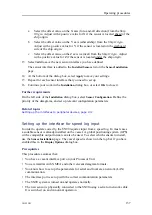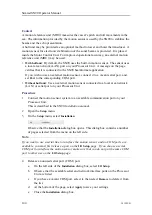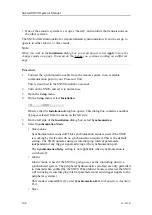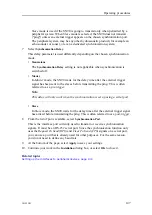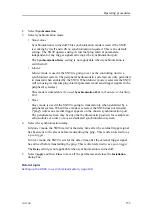
381295/B
149
• The systems are all connected to a common synchronization system.
• One of the acoustic systems is set up as "master", and controls the transmissions on
the other systems.
The SN90 offers functionality for remote transmit synchronization. It can be set up to
operate in either
Master
or
Slave
mode.
The following synchronization modes are available:
•
Stand-alone
Synchronization is turned off.This synchronization mode is used if the SN90 is
working by itself and with no synchronization required. This is the default setting.
The SN90 operates using its internal ping interval parameters, independent of any
trigger signals arriving at the synchronization port.
The
Synchronization Delay
setting is not applicable when synchronization is switched
off.
•
Master
Master
mode is used if the SN90 is going to act as the controlling unit in a
synchronized system. The peripheral hydroacoustic system(s) are only permitted
to transmit when enabled by the SN90. When
Master
mode is selected, the SN90
will run using its internal ping interval parameters and send trigger signals to the
peripheral system(s).
This mode is unavailable if you set
Synchronization Port
to
Transceiver Auxiliary Port
.
•
Slave
Slave
mode is used if the SN90 is going to transmit only when permitted by a
peripheral system. When
Slave
mode is selected, the SN90 does not transmit ("ping")
unless an external trigger appears on the chosen synchronization port. The peripheral
system may be any other hydroacoustic product (for example an echo sounder or
sonar), or even a dedicated synchronization system.
Related topics
Setting up the SN90 in a synchronized system, page 148
Synchronization using Clear To Send (CTS) and Request To
Send (RTS) signals
In many applications, the synchronisation interface is based on an RS-232 serial port.
Only the Clear to Send (CTS) and Request to Send (RTS) connections of the RS-232
interface are then used.
According to the standard specifications for RS-232, an output must generate a voltage
level of +5 to +15 VDC (logic "low"), and -5 to -15 VDC (logic "high") into a load of 3
to 7 kΩ. An RS-232 receiver must present a 3 to 7 kΩ load , converting an input of +3 to
+25 VDC to logic "low", and an input of +3 to +25 VDC to logic "high". With a positive
Содержание SN90
Страница 2: ......
Страница 186: ... 2020 Kongsberg Maritime ...
Страница 187: ......
Страница 188: ...Simrad SN90 Purse Seine and Trawling sonar Operator Manual ...



